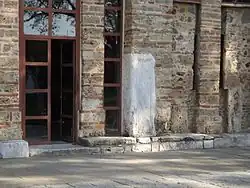Late Antiquity and Medieval sites in Kosovo
Part of series of articles upon Archaeology of Kosovo
With the decline of the Western Roman Empire, we see an intriguing development where some of the emperors of Rome are Illyrians or Dardanians. To list a few prominent ones: Justinian, Constantine, and Diocletian. They bring a breath of fresh air to the antiquated system of government of Rome and replace the capital to Constantinople, which brings forth a new surge of civilization and knowledge.[1]
While the Dark Age is in full swing in Europe, Kosovo and Balkans in general see a migration of new people in its territories, and even though not in peace, see a period of progression. The old knowledge of the Classics is not lost nor forgotten, and a new development in art and architecture starts. This puts Kosovo in an interesting position being that it becomes a bridge through which we see these different influences of civilization happen, whereas we see an influence of Romanesque, Byzantine, and later Ottoman styles of life, philosophy, religion and architecture. We also see during this tumultuous period the building of many fortifications to protect the population from the uncertainties of conquest from abroad.[2]
See also
- Illyrians
- Dardanians (Balkans)
- Roman cities in Illyria
- Archaeology of Kosovo
- Roman Period Sites in Kosovo
- Neolithic Sites in Kosovo
- Copper, Bronze and Iron Age Sites in Kosovo
References
- ^ Berisha 2012, pp. 77–78.
- ^ Luan Përzhita, Kemajl Luci, Gëzim Hoxha, Adem Bunguri, Fatmir Peja, Tomor Kastrati, Harta Arkeologjike e Kosovës, vëllimi. 1, Pristina, Akademia e Shkencave dhe e Arteve e Kosovës, 2006, p. 198, ISBN 9789951413596.
Sources
- Berisha, Milot (2012). "Archaeological Guide of Kosovo" (PDF). mkrs-ks.org.
Bibliography
- Nicholas Marquez Grant, Linda Fibiger. "Kosovo" The Routledge Handbook of Archaeological Human Remains and Legislation, Taylor & Francis, 2011, ISBN 1136879560, ISBN 9781136879562
- Luan Përzhita, Kemajl Luci, Gëzim Hoxha, Adem Bunguri, Fatmir Peja, Tomor Kastrati. "Harta Arkeologjike e Kosovës vëllimi 1/ Archaeological Map of Kosovo vol.1" Akademia e Shkencave dhe e Arteve e Kosovës, Pristina 2006, ISBN 9789951413596
- Cultural Heritage Without Borders. "An Archaeological Map of the Historic Zone of Prizren", CHwB Kosovo office, Report Series No.2/2006.
- Gail Warrander, Verena Knaus. "Kosovo 2nd ed." Bradt Travel Guides, 2011, ISBN 1841623318, ISBN 9781841623313
- Besiana Xharra, Source: Balkan Insight, "Kosovo's Lost City Rises From Earthy Tomb", https://archaeologynewsnetwork.blogspot.com/2011/01/kosovos-lost-city-rises-from-earthy.html#.UR95dvI7owo Archived 17 May 2021 at the Wayback Machine
- Tom Derrick, "Ulpiana: Digging in Kosovo" source: https://web.archive.org/web/20130308102614/http://www.trinitysaintdavid.ac.uk/en/schoolofclassics/news/name,14937,en.html
- Philip L. Kohl, Clare Fawcett, "Nationalism, Politics and the Practice of Archaeology", Cambridge University Press, 1995, ISBN 0521558395, ISBN 9780521558396
|
This article is issued from Wikipedia. The text is available under Creative Commons Attribution-Share Alike 4.0 unless otherwise noted. Additional terms may apply for the media files.